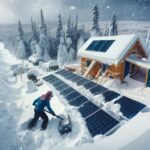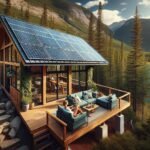Imagine harnessing the sun’s energy in the breathtaking isolation of the Canadian wilderness. Maintaining a solar system in such a remote setting can seem daunting, yet it’s essential for ensuring a reliable power source. Did you know that nearly 90% of solar system failures stem from improper maintenance? With unpredictable weather and rugged terrain, you might wonder how to keep your solar panels functioning optimally.
Understanding the unique challenges of the wilderness is crucial for extending the life of your system. From regular cleaning to monitoring battery health, each step you take can make a significant difference. Dive deeper into these essential tips to empower your off-grid lifestyle and enjoy the benefits of sustainable energy even in the most remote corners of Canada.
Tips To Maintain Your Solar System In Remote Canadian Wilderness
- Inspect Regularly: You’ll want to check your solar panels at least once a month. Snow, dirt, or debris can block sunlight, reducing efficiency. Think of it like checking your garden; a little attention goes a long way!
- Clean Panels: Cleaning your solar panels isn’t just a suggestion, it’s essential. You can use a soft cloth or a sponge with mild soapy water. Avoid harsh chemicals that could damage the surface. It’s similar to washing your car—you want to keep it shiny and functional.
- Monitor Performance: Keep an eye on your solar energy production. If there’s a sudden drop, something might be wrong. Use monitoring systems to receive alerts. How rewarding is it to see your solar lifestyle thriving, right?
- Check Wiring and Connections: Inspect all wiring for signs of wear or exposure. In the wilderness, wildlife can sometimes be curious. Tighten any loose connections to prevent power losses. Just like securing your tent against the wind, you want it all to stay in place!
- Adapt for Weather Changes: Be prepared for unpredictable weather. You might need to adjust your setup, like angling your panels for maximum sunlight in winter months. Isn’t it fascinating how adapting your solar system can make such a difference?
- Consider Off-Grid Solutions: Think about battery storage options for cloudy days or extended trips. Investing in quality batteries not only enhances your solar panels’ lifespan but also ensures you have power when you need it most.
- Schedule Professional Maintenance: Don’t shy away from hiring a professional for a thorough check. Experts can spot potential issues you may miss. Think of this as giving your solar system a health check-up.
Understand The Basics Of Solar Systems
Understanding how your solar system works is crucial to maintaining its efficiency in the remote Canadian wilderness. By grasping the basics, you can extend the life of your solar panels and optimize your solar lifestyle.
Components Of A Solar System
Solar panels are just one part of your solar system. Typically, systems include inverters, batteries, and charge controllers. Inverters convert sunlight into usable electricity, while batteries store that energy for cloudy days or nighttime use. Charge controllers regulate the flow of energy to prevent overcharging and damage. Each component plays a vital role in ensuring your setup works effectively. Think of it like a team; when everyone plays their part, the game goes smoothly. Are you familiar with your system’s components? If not, it’s worth diving deeper.
 The worst times to start your off-grid solar cabin project in Canada
The worst times to start your off-grid solar cabin project in CanadaHow Solar Energy Works
So, how does solar energy actually work? When sunlight hits your solar panels, it creates an electric current through photovoltaic cells. This current is then transformed into the electricity you use in your home. It’s like having a mini power plant at your fingertips, turning sunlight into energy when you need it most. The more you understand this process, the better you can manage your solar energy and its benefits. Using a reliable monitoring system can help you track how much energy you’re producing. Curious about maximizing that energy? Exploring innovative ways to adapt your system could lead to significant improvements in efficiency.
Embracing a solar lifestyle means staying informed and proactive about your solar system. Why not take a moment to check how your system aligns with these basics?
Regularly Inspect Your Solar System
Regular inspections are crucial to keep your solar system running smoothly. By checking components consistently, you can prevent minor issues from becoming major problems. Let’s jump into two key areas to focus on.
Check Solar Panels For Dirt And Debris
You should check your solar panels for dirt and debris at least once a month. Think of it as giving your solar system a little TLC. Leaves, snow, or dust can accumulate and block sunlight, significantly reducing efficiency. Imagine trying to see through a dirty window—it’s tough, right? The same applies here. For optimal performance, use a soft brush or cloth to gently remove any obstructive materials. Don’t forget to check those hard-to-reach spots. If you live in an area with heavy snowfall, consider integrating a snow removal strategy, like a snow rake. Staying proactive about your solar panels ensures they work effectively, helping you maintain your solar lifestyle without interruptions.
Read also: The worst times to start your off-grid solar cabin project in Canada
The worst times to start your off-grid solar cabin project in Canada Why off-grid solar cabins are the new glamping in Canada
Why off-grid solar cabins are the new glamping in CanadaMonitor Inverter Functionality
You must monitor your inverter functionality regularly, as it’s the heart of your solar system. The inverter converts the DC electricity from your solar panels into AC electricity for your home. If it malfunctions, your whole system is affected. Check the inverter’s indicator lights and error codes; they’re designed to signal any issues. Have you ever noticed your smartphone slowing down? It’s frustrating, isn’t it? A poorly functioning inverter can feel the same way. By keeping tabs on operating conditions and output levels, you can catch anomalies early. Plus, investing in monitoring technology can help you track performance from your phone. This way, you can focus on enjoying the beauty of the wilderness while ensuring your solar panels for life continue to power your adventures effectively.
Keep Your Battery System Healthy
Maintaining a healthy battery system is crucial for maximizing the efficiency of your solar panels. After all, your energy storage directly affects your sustainable off-grid lifestyle in the Canadian wilderness.
Test Battery Voltage Regularly
Test your battery voltage regularly to ensure it’s operating within the correct range. This simple task can prevent unexpected power outages and prolong the life of your solar system. Why wait until it’s too late? You can use a multimeter to measure the voltage easily. A healthy battery typically sits around 12.6 volts when fully charged. If it falls below 12.4 volts, you might need to recharge it or check for deeper issues. Remember, just like you wouldn’t ignore a low fuel gauge in your vehicle, don’t overlook your battery’s voltage! Keeping a log of these readings can help you spot trends and address problems before they escalate.
Understand Battery Maintenance Needs
Understand your battery maintenance needs to maximize performance. Different batteries require varying levels of care. For instance, flooded lead-acid batteries need regular water checks, while sealed batteries are maintenance-free. Are you treating your batteries like a precious resource? Just as you would schedule regular oil changes for a car, perform routine inspections on your battery system to clean terminals and check for corrosion. This will help your batteries stay in peak condition and ensure that your solar energy storage is reliable. Plus, incorporating good maintenance habits not only enhances efficiency but can also save you money in the long run. If you want to dive deeper into battery options and maintenance strategies, check out our specialized content at Solar Panels for Life to elevate your solar experience.
Read also: The worst times to start your off-grid solar cabin project in Canada
The worst times to start your off-grid solar cabin project in Canada Why off-grid solar cabins are the new glamping in Canada
Why off-grid solar cabins are the new glamping in Canada Don’t fall for these common myths about off-grid solar cabins
Don’t fall for these common myths about off-grid solar cabinsProtect Your Solar Equipment From The Elements
Maintaining your solar equipment in the unpredictable Canadian wilderness requires proactive measures. The right strategies can significantly extend the life of your solar panels and safeguard your investment in a solar lifestyle.
Use Weather-Resistant Materials
Utilizing weather-resistant materials is crucial. You’ll want to ensure that any mounting hardware or protective coverings can withstand harsh weather conditions. Think about it—would you trust lightweight materials during a snowstorm? Invest in corrosion-resistant metals and UV-protected plastics to enhance durability. These choices not only prolong the life of your solar panels but also help maintain their efficiency. For example, high-quality conduit can shield wiring from moisture and pests, while roof seals will prevent leaks and damage. By proactively fortifying your system with the best materials, you’re not just maintaining solar technology; you’re ensuring the long-term viability of your energy source in the wilderness.
Clear Snow And Ice Accumulation
Clearing snow and ice accumulation is essential for optimal performance. After heavy snowfall, don’t wait for the sun to do all the work; get outside and gently remove the buildup. Capturing sunlight is key, and thick layers of snow can block solar energy from reaching your panels. A soft brush can be your best friend here—avoid metal scrapers that might scratch or damage the surface. Regularly checking your panels for ice is just as important, especially after freezing rain. When you keep your solar panels clear, you maximize their efficiency and ensure that your investment in solar panels for life continues to pay off. So, roll up your sleeves and make it a routine; your solar energy production will thank you!
Consider this: a clean solar panel can generate up to 30% more electricity than a dirty one. Isn’t that worth the effort?
Read also: The worst times to start your off-grid solar cabin project in Canada
The worst times to start your off-grid solar cabin project in Canada Why off-grid solar cabins are the new glamping in Canada
Why off-grid solar cabins are the new glamping in Canada Don’t fall for these common myths about off-grid solar cabins
Don’t fall for these common myths about off-grid solar cabins Amazing things nobody tells you about off-grid living in Canada
Amazing things nobody tells you about off-grid living in CanadaOptimize The Placement Of Your Solar Panels
Finding the right placement for your solar panels is crucial to maximize energy production. Proper placement means you’ll capture the most sunlight possible, making your solar lifestyle even more efficient.
Assess Sunlight Exposure Throughout The Year
You should start by assessing sunlight exposure for each season. Why? Because sunlight angles shift dramatically as the year progresses. In the summer, the sun rises higher in the sky, maximizing direct sunlight on your panels. In contrast, during winter, the sun is lower, which can cause shadows from nearby trees or buildings. You can use tools like solar pathfinders or apps that simulate sunlight exposure to find the ideal spots for your panels. Imagine your solar panels as plants; just like they need the sun to thrive, your energy production will flourish when they’re in the right place. With careful planning, you can ensure that your solar panels generate optimal energy all year round.
Adjust For Seasonal Changes
You must adjust your solar panel angles to adapt to seasonal changes for maximum efficiency. Have you ever noticed how the sun’s position shifts over the winter and summer months? By tilting your solar panels at an angle that reflects the sun’s path, you can dramatically improve performance. For instance, during winter, try adjusting the panels to a steeper angle to capture more sunlight. Conversely, flatten them in summer to prevent overheating and adjust for the higher sun. Think of this as a strategy—you’re playing the field to get the best results from your investment in solar energy. Besides, small adjustments can lead to significant gains! By actively managing panel orientation, you’re not only enhancing energy output but also committing to a sustainable lifestyle.
Plan For Remote Access Needs
Planning for remote access is crucial when maintaining your solar system. Life in the wilderness brings unique challenges, and staying prepared can make all the difference.
Create A Maintenance Schedule
Crafting a maintenance schedule ensures you regularly check on your solar panels. Think about it: how often do you really inspect your system? Aim for monthly inspections to keep everything running smoothly. During these checks, remove snow or dirt that can block sunlight and lower efficiency. You wouldn’t let your car go without regular oil changes, right? Similarly, your solar panels deserve consistent attention. Consider marking these dates on your calendar or setting reminders on your phone. Regular maintenance isn’t just about protecting your investment; it’s about optimizing your solar lifestyle for enhanced energy production.
Ensure Spare Parts Are Available
Keeping spare parts on hand is a smart strategy when you’re far from the nearest store. Imagine a storm knocks out your inverter—what do you do then? By having replacements for crucial components like fuses, connectors, and even wiring, you can quickly address any issue that arises. You wouldn’t want to be left in the dark, literally! Stocking up on spare parts allows you to maintain your system without long delays. Also, consider creating an organized storage solution for these parts; it can save you time and stress when you need them the most. This approach not only safeguards your equipment but also enhances the longevity of your solar panels.
So, why wait? Start planning for remote access needs today, and explore how Solar Panels for Life can help support your off-grid energy solutions.
Conclusion
Maintaining your solar system in the remote Canadian wilderness is essential for ensuring reliable energy. By following the practical tips outlined, you can enhance the efficiency and longevity of your solar setup. Regular inspections and cleaning will keep your panels performing at their best while monitoring performance helps you catch issues early.
Adapting your system to changing weather conditions and planning for remote access are crucial for off-grid living. With a proactive approach to maintenance and a solid understanding of your solar components, you’ll not only optimize your energy production but also fully enjoy the beauty of your wilderness surroundings. Embrace these practices and make the most of your sustainable energy source.
